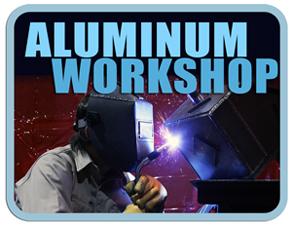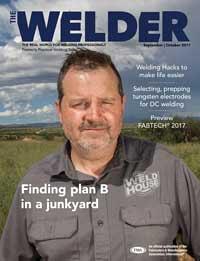President
- FMA
- The Fabricator
- FABTECH
- Canadian Metalworking
Categories
- Additive Manufacturing
- Aluminum Welding
- Arc Welding
- Assembly and Joining
- Automation and Robotics
- Bending and Forming
- Consumables
- Cutting and Weld Prep
- Electric Vehicles
- En Español
- Finishing
- Hydroforming
- Laser Cutting
- Laser Welding
- Machining
- Manufacturing Software
- Materials Handling
- Metals/Materials
- Oxyfuel Cutting
- Plasma Cutting
- Power Tools
- Punching and Other Holemaking
- Roll Forming
- Safety
- Sawing
- Shearing
- Shop Management
- Testing and Measuring
- Tube and Pipe Fabrication
- Tube and Pipe Production
- Waterjet Cutting
Industry Directory
Webcasts
Podcasts
FAB 40
Advertise
Subscribe
Account Login
Search
Aluminum Workshop: Choosing a filler alloy to weld QC-7 mold plate
- By Frank Armao
- September 21, 2017
- Article
- Aluminum Welding
A customer sent in a piece of very thick aluminum plate (about 8 in. thick) for me to weld. The alloy is called QC-7. I’ve been trying to find a chemistry for the alloy to choose the correct filler alloy, but I can’t seem to find it. Can you help?
First, you need to understand that virtually all of the molds for injection molding or blow molding of plastics are made from aluminum, usually in the form of thick plate. Some of these are cast plates and some are forged plates, depending on the manufacturer. QC-7 is a mold plate manufactured by Arconic; however, there are over 50 suppliers of cast or forged mold plates and virtually all of them consider their mold-plate alloy to be proprietary. Obtaining an actual lot chemistry for your particular plate is usually very difficult, if not impossible.
I can tell you, though, that all of these alloys are either 7075, 2618, or variations of them. Some of you may remember that 7075 is normally considered to be unweldable with arc welding, as is 2618. That might make you think that you shouldn’t weld at all on any of these alloys, which isn’t necessarily so.
These alloys are routinely welded using either 4043 or 5356 filler. How is that possible? The answer is that the advisability of welding these alloys is case-specific. Most of the demand for welding on these mold-plate alloys is to repair worn or mismachined surfaces. Such welds are not structural welds and are under only very low stress. In these cases, it is permissible to make such a repair using arc welding.
So which filler should you use—4043 or 5356? As I mentioned previously, you can use either. One application for which 5356 is preferred is to repair the part of the mold that forms the finished surface of the molded part, especially if the part has any sort of graining machined into it. An example is an instrument panel cover. In this case, the higher hardness of the 5356 deposit more closely matches the hardness of the mold plate, so the final graining will match better.
I must warn you that all of these alloys are still basically unweldable from a structural standpoint. Under no circumstances should you perform structural welding on any of the mold-plate alloys. Never weld lifting lugs or perform other structural welds on these alloys. You could live to regret it.
About the Author

Frank Armao
Aluminum Consulting Inc.
440-479-0239
About the Publication
Related Companies
subscribe now

The Welder, formerly known as Practical Welding Today, is a showcase of the real people who make the products we use and work with every day. This magazine has served the welding community in North America well for more than 20 years.
start your free subscription- Stay connected from anywhere

Easily access valuable industry resources now with full access to the digital edition of The Fabricator.

Easily access valuable industry resources now with full access to the digital edition of The Welder.

Easily access valuable industry resources now with full access to the digital edition of The Tube and Pipe Journal.
- Podcasting
- Podcast:
- The Fabricator Podcast
- Published:
- 04/16/2024
- Running Time:
- 63:29
In this episode of The Fabricator Podcast, Caleb Chamberlain, co-founder and CEO of OSH Cut, discusses his company’s...
- Trending Articles
Sheffield Forgemasters makes global leap in welding technology

ESAB unveils Texas facility renovation

Engine-driven welding machines include integrated air compressors

How welders can stay safe during grinding

The impact of sine and square waves in aluminum AC welding, Part I

- Industry Events
16th Annual Safety Conference
- April 30 - May 1, 2024
- Elgin,
Pipe and Tube Conference
- May 21 - 22, 2024
- Omaha, NE
World-Class Roll Forming Workshop
- June 5 - 6, 2024
- Louisville, KY
Advanced Laser Application Workshop
- June 25 - 27, 2024
- Novi, MI



























